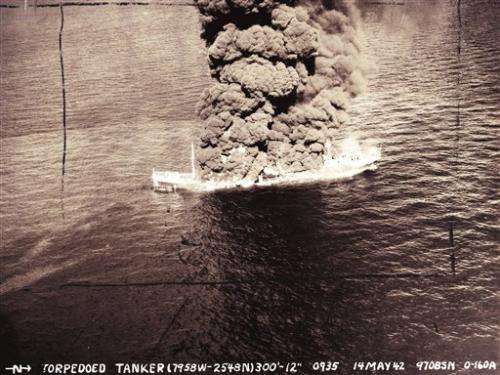Study says most shipwrecks a minor US pollution threat

Shipwrecks lying deep off America's coasts are more often historical artifacts than present-day threats from leaking old oil tanks, a new federal report says.
While 87 of the ships—most sunk during World War II by German submarines—have the potential to leak tens of millions of gallons of oil, the report issued Monday concludes that "the scope of the problem is much more manageable than initially feared."
"Our coastlines are not littered with 'ticking time bombs,'" government scientists wrote. They note that only six of the 87 are likely to be serious enough to be disasters to local economies and coastlines, the report said.
Still the wrecks are hulking reminders of lost lives in war and the environmental mess of oil, especially to Frank Terry, who experienced them firsthand.
The first of two German torpedoes hit the oil tanker ship W.D. Anderson as it steamed along the Florida coast one late February night in 1942. Terry ran to the side, hurled himself over the railing and into the water. His boat was in flames and the 23-year-old was swimming for his life.
"I just wanted to get out of there," he recalled Monday from his home in Parkesburg, Pennsylvania Days after the sinking 15 miles off southeast Florida, Terry wrote in an account for The Associated Press: "I saw the ship go up in flames while I raced from death as the burning oil spread over the water."
He bumped into dead bodies in the tainted water. A spotlight bore down on him. He figured it was the German U-boat, so he ducked. But he had to come back up to breathe. American voices yelled to him and American arms tried to pull him aboard. But Terry was coated in oil and he slipped away from rescue at first.
Eventually, Terry was hauled aboard, hosed down, and the next day in the hospital he found out he was the sole survivor.
And now, 71 years later, the federal report says Terry's old ship is not only one of the 87, it is one of the six likely worst cases. It's a gravesite for 35 souls, but also a potential despoiler of the tourist-dependent Florida coast because it may still have more than 5.6 million gallons of crude oil on board. Jupiter is the nearest city.
The overall picture, though, is not as bad as expected. The potential for pollution from the 87 shipwrecks is less than half the 200 million gallons the BP well spewed into the Gulf of Mexico in 2010 in that disaster, agency officials calculate.
There are about 20,000 shipwrecked vessels off the nation's coastlines. Most of those either finished leaking long ago, ran on coal instead of oil, are too small or aren't near U.S. vulnerable land.
"There are only six that really keep me up at night, but we don't know where they all really are," said Lisa Symons of the National Oceanic and Atmospheric Administration, who wrote the study. Those six have the biggest potential to be coastal pollution problems because even if they do spill only 10 percent of their oil, they could cause what could be a local-scale disaster, she said. They don't have to be a worst-case spill to be a disaster.
Symons said NOAA doesn't know the exact location of all of them, just where they were last seen before they sank. Three of the six worst potential problems are off Florida: the one near Jupiter, one 25 miles north of the Florida Keys, and another south of the Keys. Another is 100 miles (160 kilometers) southeast of Savannah, Georgia; 50 miles east of Charleston, South Carolina and 60 miles (96 kilometers) north of Montauk Point, New York.
Of the 87 ships identified as potential polluters by NOAA, 52 were lost in World War II, up and down the Atlantic coastline.
Others were lost in crashes, fires and storms, including the Edmund Fitzgerald. That ship's sinking in Lake Superior was turned into a classic 1970s ballad. That ship and another aren't even in U.S. waters but are close enough they can pollute American waters, NOAA officials said.
Given that some vessels can't be found and others aren't as big a threat, NOAA has identified 17 ships that have a known location and that need to be investigated further to see if the oil could be removed. Removing oil in advance, before it leaks, is far easier than waiting till after it spills into the water, Symons said.
The report is more than about potential pollution, said Jim Delgado, director of marine heritage for NOAA. He said, looking at these wrecks, he was struck by "the incredible human stories wrapped up in these ships."
One ship not on the list, but a potential oil pollution threat, is the USS Arizona, the battleship sunk at Pearl Harbor. Symons said it is now a National Park Service monument and that agency and the U.S. Coast Guard are monitoring it for major leaks.
The Arizona leaks oil every day, Symons said, adding that some people call them "sailors' tears."
Next month, NOAA will examine the W.D. Anderson to see if it can or should be drained of oil, but they will be careful since it is a gravesite for 35 people, Symons said.
Terry, the ship's sole survivor is conflicted.
"I have friends in there," he said, but added that removing oil from the ship is "a very good idea. For one, it would give me closure. I don't sleep at night."
© 2013 The Associated Press. All rights reserved.



















